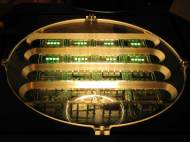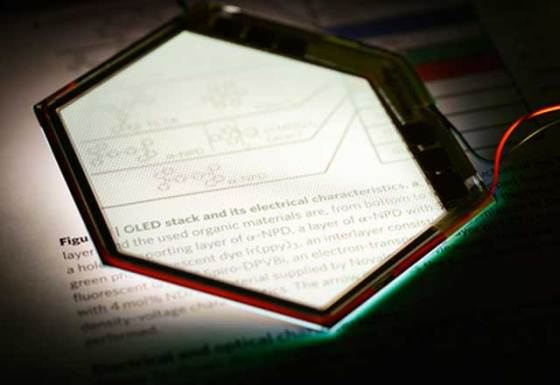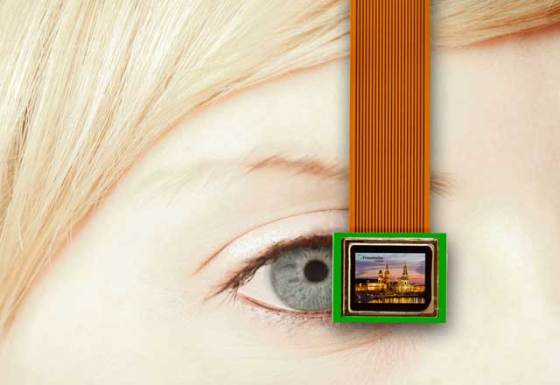New advancements in OLED display technology
 Organic light emitting diodes (OLEDs) are slowly fighting their way into the display market since there are various reports about improvements in their production, efficiency, and longevity. This article covers two recent advancements from European research groups – one inventing new modeling technique that can predict the output color and second group that came with a new kind of production which saves costs and improves the radiance of the OLED.
Organic light emitting diodes (OLEDs) are slowly fighting their way into the display market since there are various reports about improvements in their production, efficiency, and longevity. This article covers two recent advancements from European research groups – one inventing new modeling technique that can predict the output color and second group that came with a new kind of production which saves costs and improves the radiance of the OLED.
OLEDs emit light themselves, and unlike the ordinary liquid crystal display screens of today, they work without background lighting. Since they can be produced much thiner than currently dominant technologies, OLEDs can also be flexible and transparent, making them useful for new twists in lighting and displays. Unlike LEDs, OLEDs are made of very low-cost materials, but the longevity of organic materials, consistency of the lighting and inefficiency of mass production kept the technology hindered.
New modeling technique which predicts the color of OLEDs
White OLEDs consist of stacked, ultra-thin layers, each emitting its own light color, all together resulting in white light. Up until recently, it was impossible to predict the exact light color produced by a white OLED and manufacturers had to rely on trial and error. Researchers at Eindhoven University of Technology (TU/e), Philips Research, Dresden University of Technology and other institutes have developed a method that allows the color of light produced by a specific OLED design to be predicted with high precision.
To predict what kind of light an OLED design will produce, TU/e researchers made computer models of the electronic processes in the OLED on the molecular scale. Although each change in the electrical charge also influences all the other charges, the researchers managed to overcome this problem by using Monte Carlo methods with nanosecond steps. The results proved to correspond very well to measurements carried out at Philips on real OLEDs made at Dresden University of Technology.
This approach allows the researchers to predict where light is produced and lost in the ultra-thin layers. That enables development of OLEDs that can produce the same amount of light while consuming less electric power. The researchers expect that the efficiency can still be increased by a factor of three. Manufacturers can also use the method to determine how thick the different layers need to be, and how much pigment has to be added to the layers in order to design OLEDs with specific colors.
New manufacturing method saves costs and improves the radiance of the OLED
Aside their lifespan, the extremely high acquisition costs are impeding a widespread breakthrough of OLEDs. At the moment, the technology is being used primarily for small screen sizes for viewfinders on digital cameras, cellphone beamers and data glasses. A group of researchers at the Fraunhofer Institute teamed up with VON ARDENNE Anlagentechnik GmbH to develop new production methods for OLED microdisplays.
They are developing a technology which allows manufacture of mini-OLED screens without color filters. Color filters are used to suppress two of the three color ranges of an OLED subpixel, but the fact they are an additional layer applied over the OLED, it automatically dims the generated light and allows about 20 percent of the emitted light to be used.
In order to circumvent the use of the color filter, the red, green and blue subpixels – which are integral to the depiction of a color image – must be loaded onto the OLED directly. This was achieved thanks to technology developed by VON ARDENNE. The technology facilitates the targeted vaporization of organic layers locally, under heat. In this manner, surfaces can be processed that are smaller than 10 square micrometers (5 times more efficient compared to other currently available methods).
“In order to use the technology for OLED microdisplays, we redesigned the entire manufacturing process. It is therefore possible to load the red, green and blue color pixels directly. The use of the color filter is no longer necessary and it is possible to use 100 percent of the light emitted”, said Rigo Herold of the Fraunhofer Research Institution for Organics, Materials and Electronic Devices (Fraunhofer COMEDD).
Is the future of OLED dominance brighter?
While currently used OLED displays consume around 40 percent of the power of an LCD displaying an image which is primarily black, for the majority of images it will consume 60 to 80 percent of the power of an LCD. Unsurprisingly, displaying an image with a white background such as a document or website on OLED display consumes up to three times as much power compared to LCD displays. This occurs due to fact all three colors are being used at the same time at the majority of the display.
Aside increasing radiance, the production process of color-filter-less full-color OLED microdisplays is also less expensive since it doesn’t require manufacture of costly color filters. Less power used for the color presentation of the displays should also lead to longer battery life.
Lifespan of typical OLED displays is 40 percent less than a standard LCD screen. Although joint venture of Toshiba & Matsushita (Panasonic) resulted with an experimental OLED display able to last two times longer, there’s still a lot of space for improvement when it comes to longevity and durability of these displays.
New modeling technique which predicts the color of OLEDs allows manufacturers to greatly improve their OLED design processes and reduce the cost. At the same time, the simulations could serve to optimize energy efficiency and increase lifetime of OLEDs.












Leave your response!